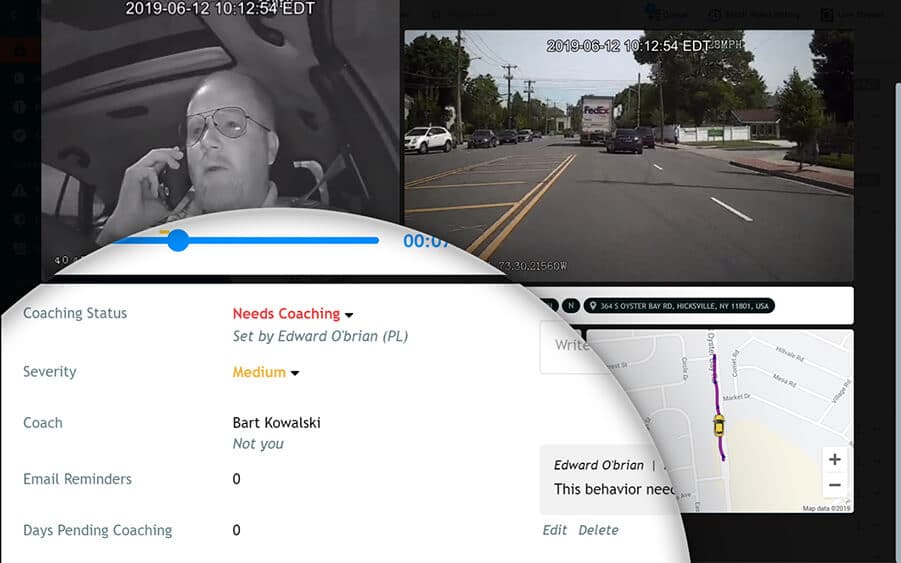About 20% of all fleet vehicles are involved in accidents each year. The average cost of an injury involving a medium/heavy truck is $330,000, and property damage from collisions can cost you an average $12,000.
Each incident halts productivity, creates paperwork, and occasionally results in litigation. These costs can impact your bottom line even harder than the accident itself. If you’re lucky, your unsafe drivers won’t end up in costly accidents, but relying on luck is an expensive luxury.

Aside from the high costs of accidents, there are routine behavior costs. For example, fuel accounts for more than 30% of fleet expenses. An increase of 5-8 MPH in speed can hike fuel consumption by up to 20%. Does your fleet have heavy duty trucks? The typical long-haul truck idles for 6 hours a day and burns nearly a gallon of fuel per hour while idling. Some quick napkin math puts that at around 1,500 gallons of diesel wasted each year, per truck! Nationwide, we’re talking close to a billion gallons of fuel.
Smart fleets are cutting into these killer expenses with proven strategies. By the time you finish reading this article, you’ll have the knowledge and tools to maintain a safer, more cost efficient fleet.
The critical, first step is knowing your drivers’ habits. Establishing a baseline will show you who needs improvement and in which types of behavior. For example, gentle acceleration/braking, staying within a reasonable speed limit, and idling awareness, can improve fuel economy by up to 40%. That’s a savings of nearly $1 per gallon.

But how do you get the message across to your drivers? We’ve found that a three-pronged attack works best.
These are the three keys to significantly improving driver behavior and safety.
Tracking driver behavior can help you quickly identify who is costing you the most money. All drivers make mistakes. But when mistakes become trends they need to be corrected. Telematics adoption for government and commercial fleets is currently hovering around 50% nationwide, so if you don’t monitor driver behavior. You’re at a disadvantage.
Driver behavior tracking solutions use engine data, advanced sensors, and GPS to provide insight into unsafe or wasteful driving habits. The most successful fleet managers use this data to create incentive programs and find coaching opportunities. When used properly, driver tracking can have a powerful ripple effect. You’ll notice a reduction in accidents, greater fuel efficiency, extended vehicle life, and lower insurance costs.

One of our customers, Mr. Sippy Beverages, wanted to raise the bar on safe driving. Operations manager, Troy Coll, believes that driver activity alerts are critical to his operations. He tells us that real-time alerts on unsafe driving are “the absolute best way to make sure our trucks are being driven to our safety standards.”
The relevant safety metrics may vary by industry and by the types of vehicles in your fleet, but whatever those metrics are, it’s important to nail them down early. The fact of the matter is, driving behavior improves when drivers know they’re being monitored. It may sound obvious, but it’s true.
40% of drivers change their driving behavior after their first safety warning. Driver scorecards are essential for coaching. They give you an easy way to keep track of driving habits (past and present), and show you which habits need improvement by individually analyzing Speeding, Harsh Accelerating / Braking, Idling, and Hours of Service compliance.
It is likely that many of your drivers are already excellent, but it’s never a bad idea to address your entire fleet. We’ve seen positive results from coaching all drivers on the basics. Even if most of it seems like common sense, it’s critical that your fleet’s drivers understand your expectations.
You should be rewarding driver excellence, not basic compliance, so make sure you set the bar properly. A little planning goes a long way. Ask yourself the following questions before implementing an incentive program:
The consensus is that non-cash rewards are better. The good vibes will last longer.
Moving the bottom 20% of fleet drivers into compliance will significantly cut avoidable expenses. But keeping top drivers happy by recognizing their efforts can also save big. The average cost of replacing an experienced driver is $5,000 – $10,000.
Before starting any incentive program, it’s important that drivers see and understand behavior scorecards. It needs to be top of mind.
Driver of the month – Fun, simple, low cost. Give your best driver (or drivers) a gift card or a choice of prizes from a catalog. If you’re on a tight budget, consider recognition awards like better routes, a bulletin board congratulatory letter, a plaque, a prominently displayed photo, or even a safety patch.
Teams may be more effective and less costly than individual competitions. Many drivers won’t want to let their teammates down. You might end up with even more happy drivers as there are more winners and more potential awards.
Say that you want to reduce moving violations by 25% during the quarter. When everyone works together to reach a fleet-wide goal, reward every driver that didn’t have a violation (in this case). Take them to lunch or gift them with a little extra time off before a holiday weekend.
These might include a quarterly or annual safety prize, or bonus for incident-free miles. Implement a point system for hitting key milestones, and offer rewards at preset point benchmarks.
Driver scorecards, coaching, and incentives play a huge role in improving driver behavior. Start small if you need to. But just make sure to start. When done correctly, you will see noticeable improvement on your bottom line.
Get started by checking out our Driver Behavior solution and reaching out to a Forward Thinking representative to learn more about how we can help.
Recent Posts
Categories
Stay in Touch
Ready to make fleet management more manageable?